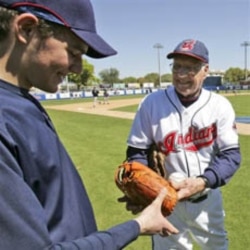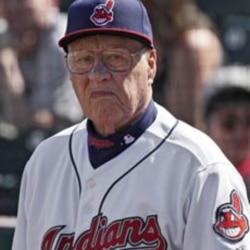Or download MP3 (Right-click or option-click and save link)
BARBARA KLEIN:I’m Barbara Klein.
STEVE EMBER: And I’m Steve Ember with PEOPLE IN AMERICA in VOA Special English. Today we tell about Bob Feller, one of the best pitchers in the history of American baseball.
(MUSIC)
CHRISTOPHER CRUISE: “I didn’t know much. I just reared back and let them go. Where the ball went was up to heaven. Sometimes I threw the ball clean up into the stands.”
BARBARA KLEIN: Those were the words of Bob Feller, talking about his pitching. Robert William Andrew Feller was born in nineteen eighteen in the small town of Van Meter, Iowa. He grew up on his family’s farm nearby. When he was not working in the fields, Bob was throwing a rubber ball against the side of a barn. Or playing catch with his father.
CHRISTOPHER CRUISE: “My father loved baseball and he cultivated my talent. I don’t think he ever had any doubt in his mind that I would play professional baseball someday.”
STEVE EMBER: Bob played baseball in high school. At the age of sixteen, he secretly signed an agreement with a major league baseball team, the Cleveland Indians. He received one dollar and a baseball signed by the Cleveland players. Bob Feller became a professional baseball player at the age of seventeen while he was still in high school. He never pitched in the minor leagues, as most players do today.
In July of nineteen thirty-six, he pitched in an unofficial game against the St. Louis Cardinals. He struck out eight batters. None of them were able to hit the balls that Feller threw. The next month, he struck out fifteen batters in a game against the St. Louis Browns.
BARBARA KLEIN: In September, Bob Feller pitched against the Philadelphia Athletics. He tied the major league record of striking out seventeen players in one game. Before his first season had ended, the New York Times reported that Bob Feller’s name was “on the tongues of a million fans.” He was said to be the best-known young person in America.
At the end of the season, Feller returned to his hometown for his last year of high school. NBC radio broadcast his graduation from Van Meter High School nationwide. He was on the cover of Time magazine at the age of eighteen.
STEVE EMBER: From the late nineteen thirties to the late nineteen forties, Bob Feller was called the best pitcher in major league baseball. He threw the ball harder than any other pitcher of his time. He was known for his fastball. People sought to measure its speed using different methods. It was measured at between one hundred fifty-seven and one hundred seventy-two kilometers an hour.
One sportswriter described the effect the young pitcher had on other players. He wrote: “They were taking the pre-game exercises when the kid kicked his left foot high and delivered the first warm-up pitch. All over the field, action ceased. Nobody said anything. Everybody just stood still and watched.”
Because of his fastball, Bob Feller had several nicknames, including “Rapid Robert” and “Bullet Bob.” He won one hundred seven major league games before his twenty-third birthday. Experts said Bob Feller was baseball’s most exciting player since Babe Ruth in the nineteen twenties.
CHRISTOPHER CRUISE: “When I picked up the ball and it feels nice and light and small, I know I’m going to have a good day. But if I pick it up and it’s big and heavy, I know I’m liable to get into a little trouble.”
(MUSIC)
BARBARA KLEIN: Bob Feller pitched on the final day of the nineteen thirty-eight season against the Detroit Tigers. He struck out eighteen hitters to set a new major league record. Today, the record is twenty. In nineteen forty, he became the first American league pitcher to throw a complete game no-hitter on opening day, the first game of the season.
Then, on December seventh, nineteen forty-one, Japanese forces attacked the American naval base at Pearl Harbor, Hawaii. The United States entered World War Two. Two days later Bob Feller halted his career to join the Navy. He was the first major league baseball player to volunteer for military service.
He served as the chief of an anti-aircraft gunnery crew on the battleship USS Alabama. He missed three full baseball seasons and most of a fourth.
STEVE EMBER: Bob Feller returned to baseball late in nineteen forty-five. He recorded his best season the next year when he won twenty-six games. In nineteen forty-seven, Feller injured his right arm. He was never the same pitcher again.
The Cleveland Indians won the American League championship in nineteen forty-eight. So Feller achieved his dream of pitching in the World Series. The Indians won the World Series against the Boston Braves, four games to two. Feller started both games that the Indians lost. However, three years later, he was the best pitcher in the American League, winning twenty-two games.
(MUSIC)
BARBARA KLEIN: In the nineteen fifties, Bob Feller helped organize the Major League Baseball Players Association. He served as the group’s first president. He helped establish a pension plan to provide money for retired baseball players.
Feller retired from baseball in nineteen fifty-six. He won two hundred sixty-six games in eighteen seasons with the Cleveland Indians. He led the American League seven times in strikeouts and six times in victories. He pitched three games without any of the batters getting hits. And he pitched a record twelve games when he permitted only one hit.
Some baseball experts believe that he might have won three hundred fifty games and set the strikeout record if he had not spent several years in the military. But Feller never regretted his choice. In two thousand one, he said:
CHRISTOPHER CRUISE: “You’ll never hear me complain about my time in the service. Baseball is insignificant when it comes to war.”
BARBARA KLEIN: Feller was once asked: “What is the most important game you ever won?” He answered: “World War Two.”
(MUSIC)
STEVE EMBER: Bob Feller was elected to the Baseball Hall of Fame in Cooperstown, New York, in nineteen sixty-two. Seven years later, professional baseball celebrated its one hundredth anniversary at the All-Star Game. Feller was honored as baseball’s greatest living right-handed pitcher.
He spoke out about protecting baseball’s standards of fairness. He opposed admitting players to the Hall of Fame if they had used performance-enhancing drugs.
BARBARA KLEIN: Bob Feller continued his connection with the Cleveland Indians as a “goodwill ambassador.” He appeared at the team’s spring training games. He helped train young pitchers. He played catch in the field while wearing his easily recognizable number nineteen uniform. He also talked to baseball fans, often signing balls or pictures of him as a player. Feller often appeared at the team’s “Fantasy Camps.” This is where baseball fans pay a lot of money to spend a week playing baseball with former players.
In two thousand nine, at the age of ninety, he put on his Indians uniform one more time. He pitched to three batters in the first Baseball Hall of Fame Classic, a game in Cooperstown between former major leaguers.
Dennis Hoffman wrote about him in his book “Legends of the Ball.” He asked the great pitcher: “If you could relive any one of the many great moments in your life, which one would it be?” Feller answered: “Playing catch with my dad between the red barn and the house.”
STEVE EMBER: Bob Feller died of leukemia in two thousand ten at the age of ninety-two. A statue of him stands outside Progressive Field, the home of the Cleveland Indians. After his death, Indians owner Larry Dolan said Feller was an important part of the team and the city: “He is Cleveland, Ohio.”
Several people wrote on Facebook about what Bob Feller meant to them. Here are some of those comments.
“I saw him pitch to several batters at an old-timers game in Florida a few years back. Even then, at age eighty-eight, he could still put one in there.”
“I almost melted when I shook his hand at a minor league game once. My childhood hero. An athlete among athletes.”
“A Cleveland hero, a baseball hero and an American hero. Thanks, Bob.”
(MUSIC)
BARBARA KLEIN: This program was written by Shelley Gollust and produced by Dana Demange. Christopher Cruise was the voice of Bob Feller. I’m Barbara Klein.
STEVE EMBER: And I’m Steve Ember. You can find scripts and audio of our programs at voaspecialenglish.com. We are also on Facebook, Twitter and YouTube at VOA Learning English. Join us again next week for PEOPLE IN AMERICA in VOA Special English.






